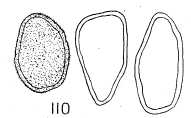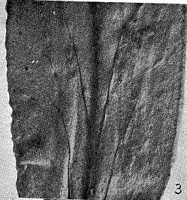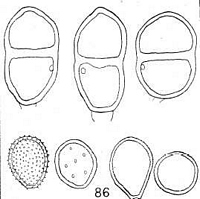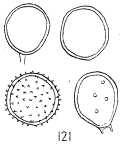|
 Puccinia celmisiae Puccinia celmisiae
SynonymsUredo celmisiae
Aecidium celmisiae-petiolatae
Uredo compositarum var. celmisiae
BiostatusPresent in region - Indigenous. Endemic
Images (click to enlarge)
Caption: FIG. 110. Aecidium Celmisiae-petiolatae G.H. Cunn. Aecidiospores from Celmisia
petiolata Hook. f. | 
Caption: FIG. 3. Aecidium Celmisiae-petiolatae G.H. Cunn. on Celmisia petiolata Hook. f. The
aecidia are covered by the tomentum of the leaf, and in the photograph appear as slightly-raised linear blisters,
principally to the right of the midr | 
Caption: FIG. 86. Puccinia Celmisiae G.H. Cunn. on Celmisia coriacea (Forst. f.) Hook. f.
Teleutospores and uredospores. | 
Caption: FIG. 121. Puccinia Celmisiae G.H. Cunn. Uredospores from Celmisia longifolia Cass.
| |
Article: Cunningham, G.H. (1924). The Uredinales, or rust-fungi, of New Zealand: supplement to Part 1; and Part 2. Transactions and Proceedings of the New Zealand Institute 55: 1-58 Wellington:.
Description: 0, I. Unknown.
II. Uredosori amphigenous, seated on discoloured spots, orbicular, 1 mm. diam., scattered, or
circinnate, when circles up to 5 mm. diam., bullate, pulverulent, reddish-orange, becoming
pallid yellow with age, on the lower surface deeply buried in the dense tomentum of the leaf,
on the upper surface long covered by the cuticle. Spores globose or obovate. 25-40 X 23-30
mmm.; epispore hyaline, somewhat closely and finely echinulate, 1-5-2 mmm. thick, cell-contents granular,
yellow; germ-pores scattered, 6-8, obscure.
III. Teleutosori similar to and arising from the same sori, chestnut-brown. Spores broadly
elliptical, 50-62 X 30-36 mmm.; apex rounded, seldom acuminate, not or slightly thickened,
base rounded or attenuate, both cells the same size and colour; not or slightly constricted at
the septum; epispore smooth, chestnut-brown, 2-3 mmm. thick, cell-contents granular;
pedicel deciduous, hyaline, fragile, 30 X 10 mmm.; germ-pore of the upper cell apical,
obscure, basal pore immediately beneath or 4 way below the septum, obscure.<
Notes: All hosts with the exception of Celmisia longifolia Cass. are endemic; the latter species occurs
also in Australia and Tasmania (Cheeseman, 1906, pp. 310-314.)
One other rust found on Celmisia in New Zealand, P. fodiens G. H. Cunn. (fig. 87), closely
resembles the species described above, but differs in several particulars. The main differences are
tabulated below, and in the text the two illustrations are placed together so that the differences
may be observed the more readily.
P. fodiens : Uredospores - Epispore sparsely and coarsely echinulate, 3 mmm. thick.
Teleutospores - 40-55 X 28-35 mmm.; apex acuminate, thickened up to 10 mmm., epispore
finely punctate.
P. Celmisiae : Uredospores - Epispore fairly closely and finely echinulate, epispore 1-5-2
mmm. thick Teleutospores - 50-62 x 30-36 mmm.; apex rounded, not or slightly thickened,
epispore smooth.
Article: Dingley, J.M. (1969). Records of plant diseases in New Zealand. New Zealand Department of Scientific and Industrial Research, Bulletin 192: 298 p. Wellington:.
Notes: Cunningham (1931a) stated that all host plants save Celmisia fongifolia Cass. were endemic,
this last extending to Australia and Tasmania. Allan (1961) showed that C. longifolia is not
present in New Zealand. Collections cited by Cunningham on this host are shown to be
characteristic of C. gracilenta and C. alpina. The rust is common on Celmisia spp. in
mountainous regions throughout New Zealand. When Celmisia spp. are cultivated as rock plants
the rust may become a problem. Petrak (1953) recorded Puccinia celmisiae from Australia on
Celmisia longifolia.
Article: Cunningham, G.H. (1924). The Uredinales, or rust-fungi, of New Zealand: supplement to Part 1; and Part 2. Transactions and Proceedings of the New Zealand Institute 55: 1-58 Wellington:.
Description: 0. Unknown.
I. Aecidia hypophyllous, seated on discoloured spots visible on the upper surface, scattered or
more commonly in small orbicular groups, pallid orange. Peridia flattened-globose, 0.25 mm.
diam., immersed, margins incurved, hyaline, covered by the dense tomentum clothing the leaf
surface. Spores polygonal, elliptical, or obovate, 27-45 X 20-26 mmm.; epispore hyaline,
densely and minutely verruculose, 1-1-5 mmm. thick, cell-contents granular, tinted yellow.
Notes: The host is endemic, and is confined to the mountain regions of the southern portion of the
South Island. (Cheeseman, 1906, p. 307.)
This rust is characterized by the depressed-globose aecidia, large spores, and hyaline, finely
verruculose epispore. Sections are necessary to determine the shape and size of the peridium.
Article: Cooke, M.C. (1890). New Zealand fungi. Grevillea 19(89): 1-4.
Description: Spores pale, verruculose, 26-30 x 22 µ.
|